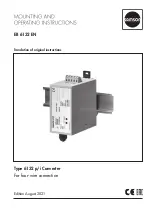
8
G.703 CODIRECTIONAL CONVERTER
2. Introduction
2.1 Functional Description
The G.703 Codirectional Converter converts the CCITT G.703 codirectional
interface to standard data-communication interfaces. The Converter can
perform two conversions:
•
Electrical Conversion —
from G.703 to CCITT V.35, V.36/V.11
(EIA RS-449/422), X.21/V.11, or EIA RS-530
• Data-Rate Conversion —
from 64 kbps to 48 or 56 kbps, when required
The electrical and rate conversions enable you to connect DCE devices to
PCM transmission equipment.
The Converter is field-selectable for either V.35 or V.11 electrical standards.
The interface connector for either V.35 or V.11 is a 25-pin D-type (“DB25”)
connector. If you select V.11, you’ll need the appropriate cable to implement
the V.36, X.21, or EIA RS-530 standard.
Operating full-duplex at a transmission rate of 64 kbps, the Converter has
a range of up to 800 meters (
1
⁄
2
mile) from the PCM equipment. The unit’s
receive-timing source is the recovered clock from the CCITT G.703 receive
pair. You can
set a jumper to select any one of these transmit-timing sources:
• Recovered clock from the received pair;
• External timing from the V.11 or V.35 digital interface; or
• Internal timing (used only for testing and diagnostics).
Two internal 16-bit buffers accommodate the difference in clocking phase.
Figure 2-1 below shows a typical application of the G.703 Codirectional
Converter. The Converter can act as a data-rate adapter, allowing you to
connect DTEs running at 48 or 56 kbps to a 64-kbps G.703-interface line.
At 48 or 56 kbps, you can set another jumper to select any one of these
ways to use the extra bandwidth:
• To guarantee the satisfaction of the “ones density” requirement,
by placing a “1” after every seven bits.
• To pass a control signal end-to-end
• As a 1200-bps asynchronous secondary sub-channel for connecting
additional DTE units over the same link.










































